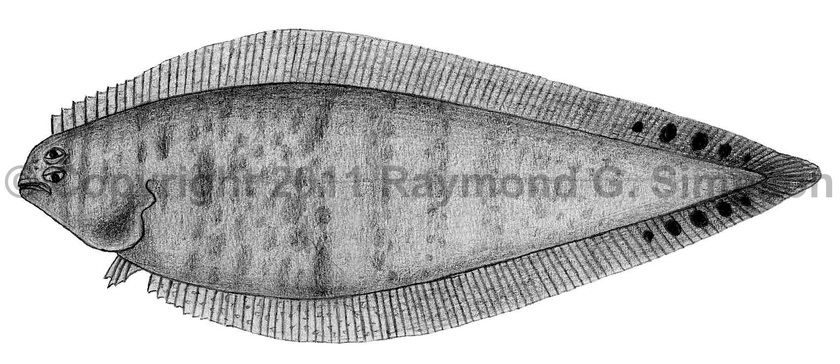
Common Name
Spottedfin Tonguefish
Year Described
Goode and Bean, 1885
Identification
Dorsal Fin Rays: 86-96
Anal Fin Rays: 69-80
Pectoral Fin Rays: none
Pelvic Fin Rays: 4
Caudal Fin Rays: 10
Longitudinal Scale Rows: 79-96
Vertebrae: 47-50
Pterygiophore pattern (1st three interneural spaces): 1-4-3
Other diagnostic characters include: well developed pupillary operculum, ocular side upper jaw usually toothless, ocular side of lower jaw without fleshy ridge, and blind side of dorsal and anal fins usually scaleless (sometimes with 1-2 scale rows at base).
Color
Varying shades of mottled brown with indistinct crossbands that do not extend onto fins, depending on substrate. Opercle body colored. Peritoneum unpigmented. Dorsal and anal fins body colored with 1-5 conspicuous dark spots on the posterior third of fins. Caudal fin dark to black. Blind side pale with no melanophores.
Size
Mature adults from 90-190mm. Maximum size to 207mm
Habitat
Inner continental shelf from 6-183m (mostly 20-80m), over calcareous mud and sand bottoms, shell bottoms, and hard mud. Rarely over other types of soft bottom. Adults never in estuaries. Commonly taken as bycatch in offshore fisheries.
Range Map

Range
Continental waters from NC to the Gulf of Mexico, the Caribbean coasts of Central and South America, to N. Brazil and Uruguay
References
Munroe, T.A. 1998. Systematics and ecology of western Atlantic tonguefishes (Symphurus: Cynoglossidae: Pleuronectiformes). Fish. Bull. 96(1):1-182.
Munroe, T. A. 2003. Bothidae (Pp. 1885-1895), Scophthalmidae (Pp. 1896-1897), Paralichthyidae (Pp. 1898-1921), Poecilopsettidae (Pp. 1922-1923), Achiridae (Pp. 1925-1933), Cynoglossidae (Pp. 1934-1959). In: Carpenter. 2003. The living marine resources of the Western Central Atlantic v. 3.